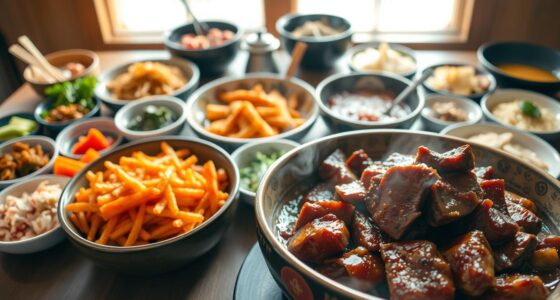When you think of food that resonates with warmth, culture, and a rich history, Georgian cuisine comes to mind. The first time you take a bite of khachapuri, that beautifully crafted cheese bread, you might feel a wave of nostalgia wash over you, reminiscent of cherished family gatherings and laughs around the table. Each dish tells a story—stories of generations passed down through time, where the heart and soul of the people are intricately woven into every ingredient and every recipe. By delving into traditional Georgian food, you embark on a journey that offers a kaleidoscope of flavors, aromas, and experiences waiting to be discovered. Whether it’s the comforting embrace of khinkali dumplings or the vibrant punch of adzhika sauce, Georgian dishes promise to create memories that linger long after the meal is over.
Key Takeaways
- Georgian cuisine features a rich blend of unique flavors and ingredients.
- Iconic dishes include khachapuri and khinkali, celebrated for their deliciousness.
- Traditional Georgian food is marked by a strong cultural heritage.
- Food in Georgia is about more than sustenance; it symbolizes community and hospitality.
- Georgian meals often integrate a variety of fresh herbs and spices to enhance flavor.
An Introduction to Georgian Cuisine
Georgian culinary traditions have captivated food lovers with their rich flavors and diverse dishes. This cuisine, rooted in centuries of history, draws influence from neighboring cultures along the Silk Road. The nation’s unique geographical location contributes significantly to its food, offering a vibrant tapestry of tastes derived from both land and sea. Dive into the fascinating world of traditional Georgian cuisine and enjoy the experience of its remarkable ingredients and flavors.
The Rich History of Georgian Cooking
Georgia’s cooking is steeped in history, coupled with influences from various civilizations over millennia. The land boasts a myriad of culinary techniques and recipes passed down through generations. Many aspects of Georgian cuisine reflect the blending of Eastern European, Middle Eastern, and Western Asian influences. Each region showcases its diverse traditions, resulting in over 90 distinct dishes that highlight the depth of flavors found in Georgian dining experiences.
Unique Ingredients Used in Georgian Dishes
At the heart of traditional Georgian cuisine lies an array of unique ingredients. Fresh produce like pomegranates, ripe tomatoes, and aromatic herbs serve as the foundation for many dishes. Walnuts play a starring role, featuring prominently in sauces and fillings. These unique ingredients, combined with regional agricultural practices, create an unforgettable culinary experience. Items such as khachapuri and khinkali highlight the reliance on local resources, showcasing the richness of Georgian flavors in every bite.
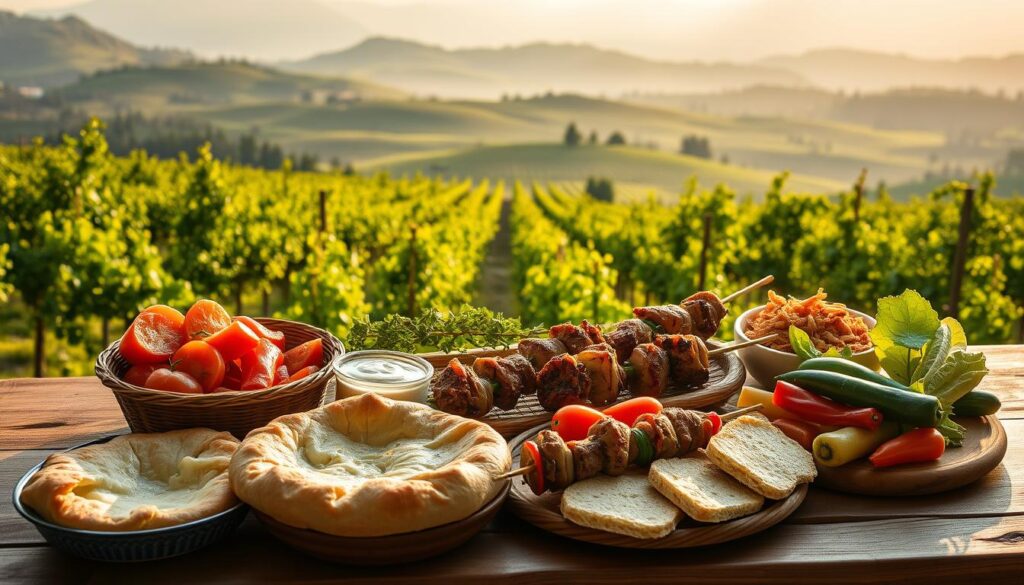
Iconic Georgian Dishes You Must Try
When exploring Georgian cuisine, you will encounter several iconic dishes that showcase the country’s rich culinary heritage. Each dish brings unique flavors and traditions to the table, representing the diverse regions of Georgia. Among the must-try Georgian dishes, khinkali, khachapuri, and lobio stand out for their delicious tastes and cultural significance.
Khinkali: A Juicy Dumpling Delight
Khinkali are traditional Georgian dumplings known for their delightful fill and unique shape. Typically filled with a mixture of ground beef and pork, you can also find vegetarian options that include potato or cheese. These dumplings resemble soup, with broth sealed inside, making each bite an explosion of flavor. Enjoying khinkali is an experience in itself. You eat them by hand, taking care to sip the delicious broth before devouring the rest of the dumpling.
Khachapuri: The Famous Cheese Bread
Khachapuri is often regarded as the national dish of Georgia. This cheese-filled bread comes in several variations, including Imeruli, Megruli, and the famous Adjaruli. Each type boasts a distinct flavor and texture. Adjaruli khachapuri is particularly special, featuring gooey cheese in the center and often topped with a butter and a cracked egg. This dish delights both locals and visitors alike, representing the heart of Georgian comfort food.
Lobio: Hearty Bean Stew
Lobio is a savory bean stew that embodies the essence of Georgian comfort food. This hearty dish is made with various beans and cooked slowly with spices such as coriander and garlic, resulting in a flavorful mix that varies by region. Often enjoyed with cornbread (mchadi), lobio is a staple in Georgian kitchens, reflecting the region’s agricultural bounty and culinary traditions.

The Influence of Georgian Wine on Its Cuisine
Georgian wine holds a special place in the heart of the country’s culinary landscape. With over 8,000 years of wine-making tradition, Georgia has earned its reputation as one of the oldest wine-producing regions worldwide. The unique technique of using qvevri, large clay jars buried in the ground for fermentation, imparts distinct flavors to Georgian wines, particularly celebrated orange varieties.
Understanding the Georgian Wine-Making Tradition
The wine-making tradition in Georgia is not just about the final product; it reflects the culture and history of the region. The combination of the Great Caucasus Mountains creating a moderate microclimate and diverse grape varieties contributes to an impressive array of wines. For instance, notable options such as Rkatsiteli, with an ABV of 12%, and Saperavi Reserve, boasting an ABV of 14%, highlight this rich heritage. You will also find the Qvevri Amber Blend, which undergoes a six-month fermentation process, showcasing the meticulous approach of Georgian vintners.
Perfect Food Pairings with Georgian Wine
Your dining experience is elevated when you explore food pairings that complement Georgian wine. Serving Khinkali, juicy dumplings filled with savory goodness, alongside a robust red wine can create a delightful contrast. On the other hand, lighter white wines pair excellently with a seasonal Khachapuri, a cheese-filled bread that beautifully showcases traditional Georgian flavors. Here’s a quick reference for some fantastic pairings:
| Dish | Recommended Wine | Notes |
|---|---|---|
| Khinkali | Saperavi Reserve | Its bold flavors enhance the juicy filling. |
| Khachapuri | Rkatsiteli | The freshness balances the richness of the cheese. |
| Kubdari | Qvevri Amber Blend | Adjika adds spice that complements the wine’s depth. |

Embracing these food pairings will enhance your culinary journey through Georgia’s vibrant and historic wine-making tradition. A sip of Georgian wine alongside a matching dish creates a harmonious dining experience that encapsulates the essence of Georgian culture.
The Role of Herbs and Spices in Georgian Cooking
In Georgian cuisine, herbs and spices play a vital role in crafting unique flavor profiles that distinguish its dishes. By utilizing an array of traditional herbs and spices, cooks can create complex and aromatic experiences on the palate. This section explores essential herbs and the flavor profiles you can expect when enjoying Georgian food.
Essential Herbs Used in Georgian Dishes
Various herbs featured prominently in Georgian cooking contribute to its distinct taste. Here are some key herbs and their uses:
- Coriander: Employed both fresh and as dried seeds, this herb is foundational in many classic recipes.
- Blue Fenugreek (Utskho Suneli): Ground into a tan powder, it adds depth to meat and vegetable dishes.
- Dried Bay Leaves: Frequently used in marinades and meat dishes, especially pork, enhancing savory flavors.
- Garlic: A staple ingredient, generously used in platforms like Shkmeruli and Chakapuli.
- Parsley: Commonly used as both an ingredient and a garnish, offering freshness to various dishes.
- Basil: Used fresh and dried in exceptional recipes such as Mushroom Chashushuli and Green Bean and Egg Bake.
- Celery: Known for its aroma and medicinal qualities, important in cooking and herbal remedies.
Flavor Profiles That Define Georgian Cuisine
The flavor profiles in Georgian dishes are shaped by a medley of spices that bring dishes to life. Key contributors include:
| Spice/Herb | Description |
|---|---|
| Khmeli Suneli | A traditional spice blend including coriander and fenugreek, essential for many Georgian recipes. |
| Ajika | A spicy paste made with red peppers, garlic, and herbs, adding heat to dishes, particularly in Samegrelo. |
| Berberis Berries | These dried berries offer a tangy flavor and are known for their high vitamin C content. |
| Svanetian Salt | A handmade mixture incorporating garlic and blue fenugreek, providing a spicy twist to seasonings. |
| Cilantro | An aromatic herb often used in garnishes and sauces, working harmoniously with spices like cumin. |
Understanding the use of these Georgian spices and herbs reveals the artistry behind the country’s cuisine, making every meal a flavorful journey worth exploring.

Georgian Sauces and Condiments to Enhance Flavors
Georgian cuisine thrives on an array of sauces and condiments that elevate the flavors of traditional dishes. The diversity and rich profiles of these Georgian sauces reflect local ingredients and culinary practices. From spicy to sweet, each sauce serves its purpose, enhancing your dining experience.
Adzhika: Spicy Pepper Sauce
Adzhika is a celebrated spicy pepper sauce that adds a fiery kick to any meal. Made from fresh peppers, garlic, and a blend of spices, this sauce offers a robust flavor that pairs wonderfully with meats, breads, and even some vegetable dishes. You can find Adzhika gracing the tables of many Georgian households and being enjoyed as a key element in various recipes.
Tkemali: Sour Plum Sauce
Tkemali captures the essence of Georgian flavors through its tangy profile. This sour plum sauce, primarily made from small tart plums, provides a delightful contrast to rich meat dishes. The traditional recipe includes a balance of herbs and spices, making it a versatile addition to many meals. As a staple in Georgian cooking, Tkemali not only enhances flavors but also offers health benefits, aiding digestion thanks to its natural ingredients.
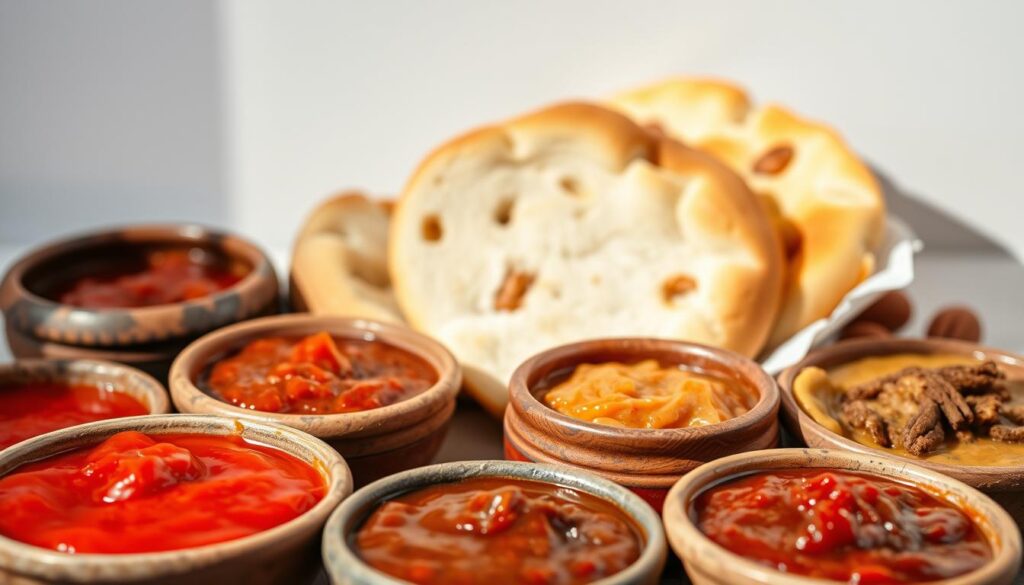
How to Experience Georgian Cuisine in the U.S.
As interest in diverse culinary experiences grows across the United States, many seek to experience Georgian cuisine without traveling abroad. With the rise of Georgian restaurants in major cities, it has never been easier to explore the unique flavors of this vibrant culture. Whether you’re dining out or trying your hand at home cooking, you can enjoy traditional Georgian recipes and delightful dishes right in your neighborhood.
Georgian Restaurants to Visit
Across the U.S., numerous Georgian restaurants offer authentic dishes that appeal to both locals and visitors. Here are some standout establishments where you can enjoy a flavorful taste of Georgia:
| Restaurant | Location | Notable Dishes |
|---|---|---|
| Kavkaz | North Miami Beach, FL | Khachapuri, Khinkali |
| Chicago Diplomat Cafe | Chicago, IL | Eggplant with walnuts, Ojakhuri |
| Supra | Washington, D.C. | Khachapuri, Pkhali |
| Tabla | Washington, D.C. | Shqmeruli, Churchkhela |
| Keipi | Greenville, SC | Ajika, Various Georgian wines |
Home Cooking: Simple Recipes to Try
If you’re inspired to recreate the tastes of Georgia in your own kitchen, several simple Georgian recipes can introduce authentic flavors to your meals. Consider the following:
- Khachapuri: This famous cheese-filled bread can be made in various styles, including the popular Adjarian version.
- Khinkali: Delightful dumplings filled with spiced meat or cheese, perfect for a fun cooking experience.
- Pkhali: Made with spinach and walnuts, this dish offers a healthy and flavorful addition to your table.
- Eggplant with Walnuts: A savory dish that combines fresh ingredients with traditional Georgian spices.
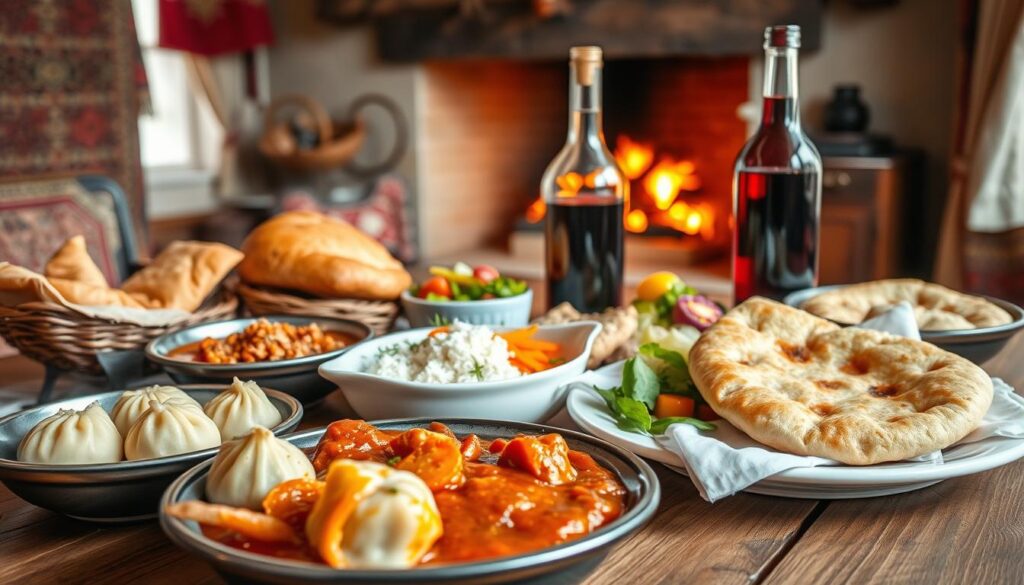
Celebrating Georgian Festivals and Food Traditions
Food plays a central role in various Georgian festivals, bringing people together to celebrate life’s significant moments. From epic weddings to vibrant cultural festivals, the emphasis on communal dining and traditional dishes highlights the nation’s rich food traditions. One of the most cherished aspects of these gatherings is the Supra, a meal that serves not only as a feast but as a display of hospitality and joy.
Traditional Dishes Served During Celebrations
During major celebrations, specific dishes take the spotlight, reflecting the cultural significance of food in Georgian life. For example, Khachapuri is a staple at religious holidays, notably Easter, where it shares the table with paska bread and red-dyed eggs. The New Year and Christmas traditions often feature Khachapuri alongside other traditional dishes like satsivi and gozinaki, highlighting its integral role in festive feasts. The Tbilisoba festival proudly showcases various types of Khachapuri, particularly the Adjaruli variety, emphasizing its prominence in the culinary landscape of Tbilisi.
Preparing for a Supra: The Georgian Feast
Preparing for a Supra is an event filled with excitement and anticipation. The table overflows with dishes symbolizing abundance, including Khachapuri, which represents hospitality. This communal feast encourages toasting, singing, and storytelling, creating a joyful atmosphere. Each dish served during the Supra, particularly during significant events like weddings and birthdays, fosters a sense of unity and celebration among guests. Khachapuri serves a dual purpose as an essential dish and a symbol of good fortune and prosperity for newlyweds. Sharing this beloved bread during meals emphasizes togetherness, making every celebration feel more special.
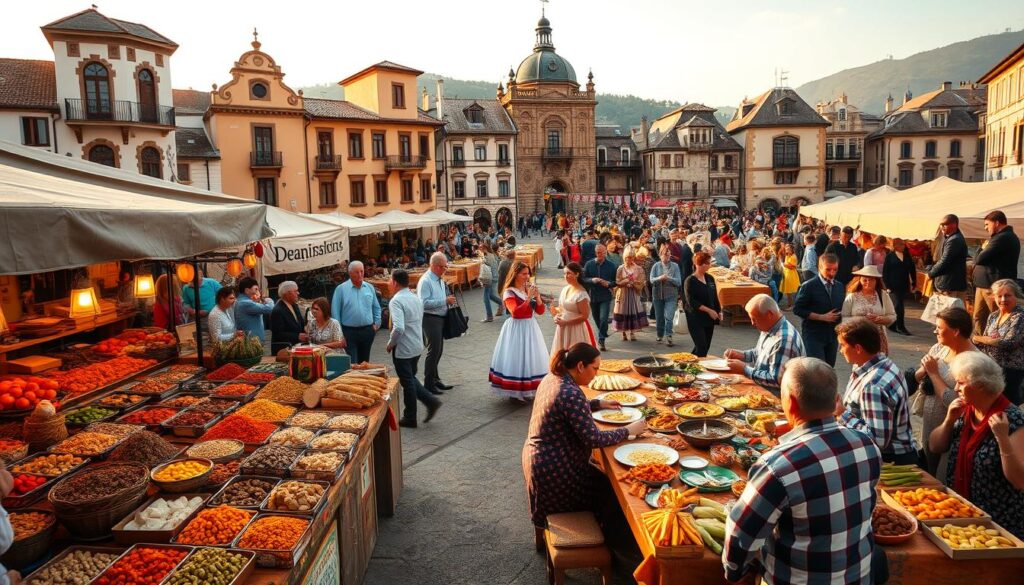
Cooking Techniques Unique to Georgian Cuisine
Georgian cooking encompasses a rich heritage of techniques that create the unique flavors and textures cherished in its dishes. Mastering these Georgian cooking techniques allows you to appreciate the intricate processes behind iconic meals, such as the beloved khachapuri, alongside other culinary delights. From baking to slow-cooked dishes, understanding these methods enhances your culinary skills and deepens your connection to Georgian culture.
The Art of Baking Khachapuri
Khachapuri stands out as a signature Georgian dish, renowned for its deliciousness and creativity. The art of baking khachapuri involves a harmonious blend of dough and cheese, often incorporating regional ingredients like Imeruli cheese or Adjarian variations. The dough is skillfully manipulated to achieve a golden crust with a light, airy interior. The topping of melted cheese, butter, and sometimes a raw egg yolk provides an indulgent experience, embodying the heart of Georgian culinary culture. Through practice, you can create this delightful dish, making it a centerpiece of your gatherings.
Slow-Cooked Dishes: A Flavor Tradition
Slow-cooked dishes hold a special place in Georgian culinary traditions. Cooking lamb chakapuli, for example, requires ample time to allow flavors to meld beautifully. Fresh tarragon and cilantro play crucial roles in this dish, accentuating the rich taste of the meat. The patience involved in preparing these slow-cooked dishes results in meals that are bursting with flavor and texture, showcasing the essence of the culinary tradition in Georgia. Incorporating herbs like parsley, dill, and mint further elevates these dishes, making them unforgettable experiences every time.

Vegetarian and Vegan Options in Georgian Cuisine
Georgian cuisine is a treasure trove of flavors, showcasing not only meat dishes but also an impressive variety of vegetarian Georgian food. With a rich heritage and an emphasis on fresh ingredients, you’ll find numerous vegan options that ensure everyone can indulge in these culinary delights. From hearty stews to vibrant salads, Georgian plant-based dishes honor tradition while embracing modern dietary preferences.
Plant-Based Dishes to Enjoy
Many traditional recipes offer delicious vegetarian or vegan versions. For example, Badrijani Nigvzit features fried eggplant rolls stuffed with walnut-garlic paste—an essential appetizer at any Georgian meal. Pkhali, a colorful assortment of vegetable and walnut appetizers, typically includes spinach, beets, and eggplant, showcasing a harmonious blend of flavors in every bite. The beloved Lobio, made from red beans and aromatic herbs, is often a mainstay in vegetarian Georgian food. You can savor various types of vegetarian khinkali, filled with ingredients like mushrooms, potatoes, or cheese.
Adapting Traditional Recipes
Adaptations of traditional recipes allow for more inclusive dining experiences. Many restaurants in Tbilisi now cater to hungry vegans by offering khachapuri made with dairy-free cheese alternatives. Additionally, you can find dishes like ajapsandali—a hearty eggplant stew—prepared without any animal products. Furthermore, as fasting periods can lead many Georgians to abstain from animal products, you’ll discover an abundance of vegetable-rich meals during these times. This adaptability explains the rising popularity of vegetarian and vegan diets as more establishments embrace the need for flexibility in their menus.
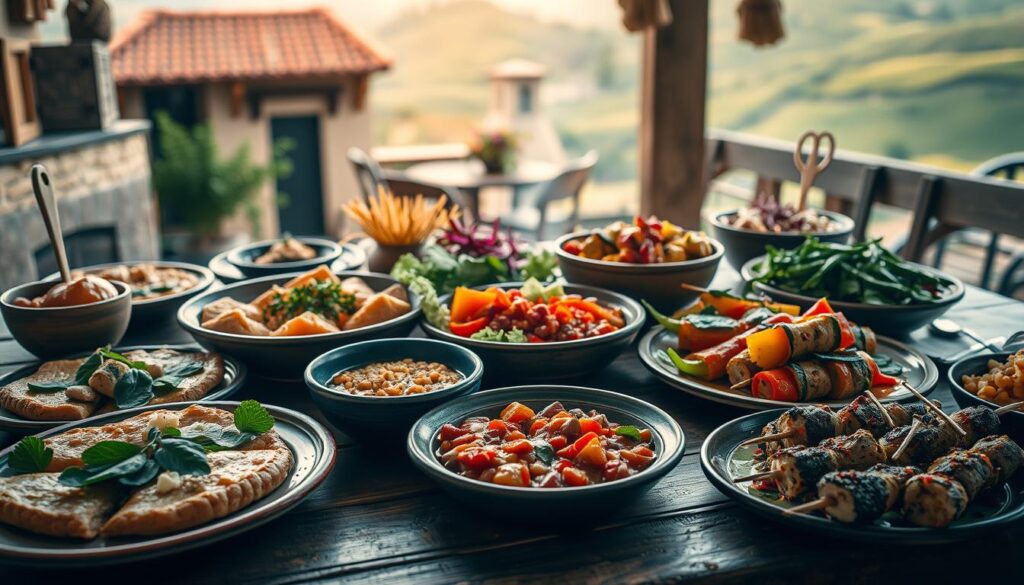
The Importance of Bread in Georgian Culture
Bread holds a special place in Georgian culture, reflecting its rich culinary traditions and the warm spirit of hospitality. You will encounter various bread varieties throughout the country, each with unique flavors and cultural significance. Traditional bakeries dot most streets, a testament to the integral role of local bread-making in daily life and festive occasions.
Types of Georgian Bread
Among the most celebrated Georgian bread is Shotis puri, renowned for its distinctive golden brown crust, achieved through baking in a traditional clay oven called a “tone.” Another popular variety is Tonis puri, both prominently featured during major celebrations such as Easter and New Year’s. These bread varieties not only accompany meals but serve as the centerpiece of many social gatherings.
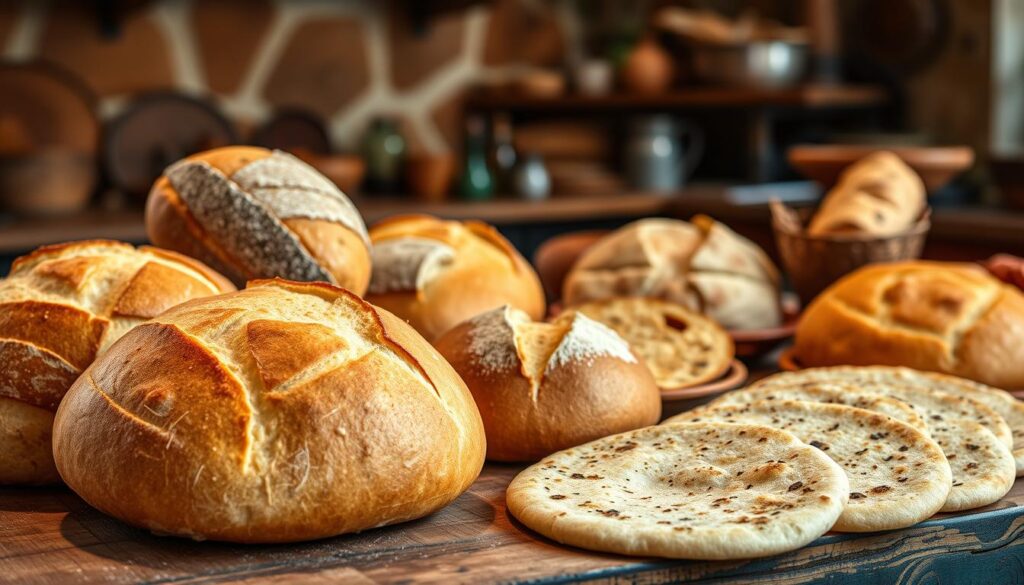
Bread as a Symbol of Hospitality
In Georgian culture, the act of breaking bread symbolizes warmth and friendship. Visitors are often welcomed with freshly baked bread, showcasing the importance of hospitality in Georgian homes. Khachapuri, a cheese-filled bread, further highlights this spirit, commonly served during family meals and celebrations. Its availability from street vendors and in restaurants makes it a beloved treat for locals and tourists alike, strengthening connections within the community.
Sweet Treats: Desserts in Georgian Cuisine
Georgian cuisine boasts a delightful array of Georgian desserts that highlight the country’s rich culinary traditions. Among these sumptuous offerings, traditional sweets play a vital role, particularly during special occasions and gatherings. Each dessert tells a story of cultural significance, often shared among family and friends. Dive into the world of these sweet treats and discover the flavors of Georgia.
Churchkhela: Traditional Candy
Churchkhela stands out as one of the most beloved traditional sweets in Georgia. Often described as a “Georgian Snickers,” it consists of nuts, predominantly walnuts or hazelnuts, that are coated in a thick mixture of grape juice and flour. The two main types, kakhetian (walnuts) and imeretian (hazelnuts), showcase the regional ingredient variations found throughout the country. Recognized as part of the Intangible Cultural Heritage of Georgia in 2015, Churchkhela reflects both the culinary and cultural heritage of this vibrant nation.
Matsoni: A Unique Yogurt Delight
Matsoni, a traditional yogurt, is cherished in Georgian households for its creamy texture and slightly tangy flavor. This versatile delight can be enjoyed on its own or used in cooking, serving as a base for various dishes. Often found alongside Georgian desserts, Matsoni adds complexity to both sweet and savory meals. Its inclusion in Georgian cuisine emphasizes not just sweetness, but also the balance and depth of flavors that characterize the country’s culinary art.
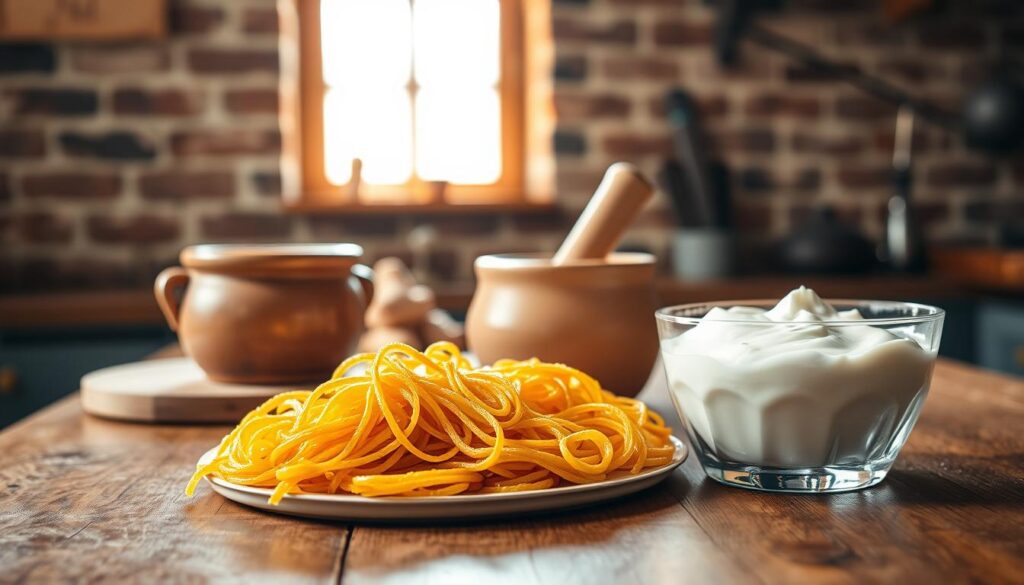
| Dessert Name | Main Ingredients | Significance |
|---|---|---|
| Churchkhela | Walnuts, grape juice | Cultural symbol and traditional sweet |
| Matsoni | Milk, yogurt cultures | Staple yogurt in Georgian households |
| Pelamushi | Grapes, starch | Harvest season staple |
| Tklapi | Fruit purée | Common snack and seasonal treat |
| Gozinaki | Nuts, honey | Luxury dessert for New Year |
| Chiri | Dried fruits | Nutritious winter snack |
Georgian desserts hold a special place in local traditions, giving a heartfelt touch to festive celebrations and everyday joy. From the nutty layers of Churchkhela to the creamy goodness of Matsoni, these traditional sweets bring the rich flavors of Georgia to life, inviting you to share in the experience. Enjoying these treats offers a delicious way to connect with Georgian culture and its culinary delights.
Exploring Regional Variations in Georgian Food
Georgian cuisine proudly showcases a kaleidoscope of regional variations, reflecting the country’s rich cultural influences and diverse agricultural landscape. Each area contributes unique dishes that highlight local ingredients and traditional cooking methods, making regional Georgian cuisine a true reflection of its geography. From the spicy favorites of Samegrelo to the hearty stews found in Kakheti, these regional distinctions bring a vibrant array of flavors to your table.
Distinct Flavors from Different Regions
The uniqueness of Georgian cuisine is largely due to the different climates and agricultural practices spread throughout the country. For example:
- Samegrelo: Known for its bold use of chili, adding a fiery kick to many dishes.
- Imereti: Famous for its variety of mushrooms, offering earthy flavors in soups and stews.
- Kakheti: Eastern Georgia boasts grilling techniques, with meats charred over grapevine embers, enhancing their natural flavors.
Highlighting Lesser-Known Dishes
While many Georgian dishes are celebrated worldwide, lesser-known foods deserve recognition for their remarkable taste. For instance:
- Khash: A hearty beef stock dish traditionally eaten in the morning, renowned for its comforting properties.
- Pelamushi: A sweet treat made from grape must and corn flour, showcasing local ingredients in dessert form.
- Jonjoli: A unique fermented shrub often foraged in Georgia, packed with flavor and used in various salads.
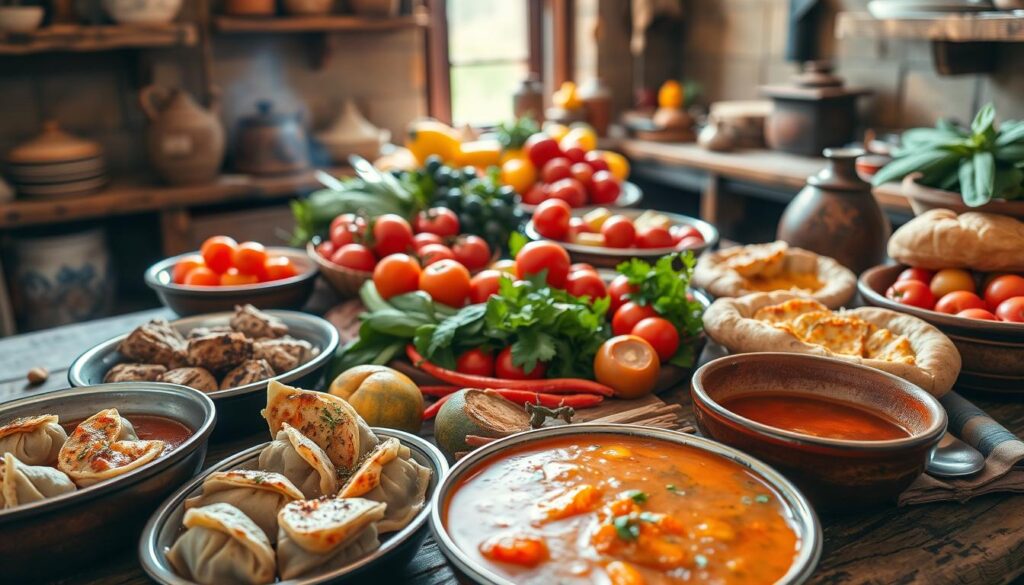
Conclusion: Why You’ll Love Georgian Cuisine
As you delve into the delightful world of Georgian cuisine, you’ll quickly discover the beautiful harmony of flavors and traditions that define this culinary gem. The communal and inclusive atmosphere found at Georgian dining tables fosters a warm dining experience that is hard to replicate. Guests gather around for a supra, emphasizing toasts and shared moments that strengthen bonds, striking a profound balance between food and community.
The Community and Warmth of Georgian Dining
Every meal is an adventure waiting to unfold, filled with rich, comforting dishes that highlight seasonal ingredients. From the delightful Khinkali to the irresistible Khachapuri, each bite represents a celebration of togetherness and joy. You’ll find that the love Georgian cuisine embodies is more than just taste; it encompasses the warmth of hospitality that welcomes everyone at the table.
Encouragement to Explore More Georgian Food
Now is the perfect time to explore Georgian food even further, stepping beyond traditional favorites and investigating regional specialties. The vibrant flavors, health benefits from local ingredients like tarragon and Imeretian saffron, and the emphasis on good company are sure to entice your culinary curiosity. Dive into the various dishes and savor the experience that comes from sharing meals with loved ones—it’s an adventure you won’t want to miss!




